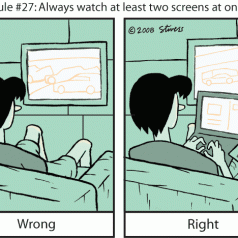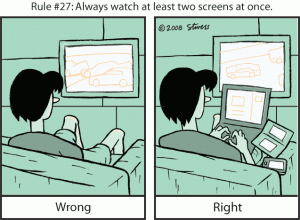3 ways brands can take advantage of the two-screen tipping point

Chocolate, alcohol and caffeine. A pretty good Saturday, but also the three things more than half of Americans surveyed by TeleNav would rather give up before parting with their cell phones. One-third would give up sex, 22 percent their toothbrushes and 21 percent are ok without shoes as long as they have their smartphone.
Last week I blogged about the two-screen tipping point at the recent MTV #VMAs. While I don’t promote taking advantage of people with addiction ![]() , I do realize how important it is for brands to understand their customers’ behavior tendencies. And our friends at TeleNav are shouting to any company that will listen: “We have trouble putting our smartphones down, no matter what we’re doing. If you want to reach us, you can reach us there.”
, I do realize how important it is for brands to understand their customers’ behavior tendencies. And our friends at TeleNav are shouting to any company that will listen: “We have trouble putting our smartphones down, no matter what we’re doing. If you want to reach us, you can reach us there.”
It’s not just a phone addiction we suffer from. It’s really media and any device that gives us access to the Internet. The most recent Nielsen “Three Screen Report” proves just that, showing 60 percent of the report’s audience spent 35 percent more time simultaneously Web surfing and TV watching than they did a year prior. And that’s data from 2010 — we can assume it has gone up since then.
For me, this is just more overwhelming evidence that brands should be focusing in on our two-screen tendencies. And those that aren’t are missing a golden opportunity. But once companies realize these tendencies we as consumers have, how can they best take advantage? Well, here are three places they can start:
1. Gaming. The two-screen trend doesn’t mean people are only engaging with two screens when the experiences are related. In fact, a lot of the time, people are checking email, a sports score or playing a game while watching a show. Part of our “technology addiction” is really an evolution of our need to multitask. Easy access to email, Web and apps on smartphones have created “checking” habits. And not being able to relax and have any down time with nothing to do has become a learned behavior for many of us.
Games provide a solid complement to watching TV because they give us something to do and can be both a passive or engaged experience. Sometimes games are mindless, but they fill our need to keep busy. And other times, our TV watching is the passive part of the experience while we become engrossed in trying to unlock the next level. Brands have an opportunity to become part of an experience relevant to their customers by creating or integrating themselves in the games people are playing more and more on their laptops, smartphones and tablets. See Best Buy’s recent agreement with CityVille as an example.
2. Online conversations with TV show audiences. I talked about this idea in my two-screen tipping point blog post last week. The thought is simple — our favorite shows are already driving people to Twitter to talk about what they’re watching. Why can’t companies participate in these conversations and facilitate dialog about what viewers are passionate about? Or even be the ones driving viewers to online conversations by placing hashtags in commercials?
If it’s the #VMAs, couldn’t a brand like Best Buy facilitate conversation on Twitter about our favorite music and musicians? If it’s the show Suits, couldn’t a designer suit company drive viewers to its mobile website where they could buy suits similar to the ones the characters are wearing? It could do so via a url placement on the show or in a commercial? Or could a Legal firm lead viewers to its new app to discuss the storyline of this week’s episode and what might happen if the situation took place in real life?
3. Sponsoring in-show engagements. I will always argue for an editorial integration like we discussed in option two over an ad buy. However, I do think a targeted buy can make sense when trying to reach two-screen users. Companies are already doing product placements during shows, right? The difference here is the type of call to action brands should be considering.
Currently, a lot of in-show placements don’t really have a call to action. They just show “celebrities” using the product. And there is some value in that. But to fully take advantage of the two-screen audience, in-show sponsorships, placements or even TV commercials need to tell users to do something with that second screen — download an app, visit a mobile website, make a discounted purchase, join a conversation.
So those are some of my thoughts. What would you do? How would you recommend taking advantage of the two-screen tipping point?


 I'm a business communications consultant at Fleishman-Hillard. I used to call myself a PR professional, but I don't use that term anymore because people hear PR and they think only media relations.We do a lot more than that at Fleishman-Hillard Kansas City (FHKC). I specialize in social media, but am trying hard to brush up on my measurement and analytics. Every strategic consulting conversation should start with your business goals and how communications can help you reach them. My motto: "Your brand is what your customers say it is."
I'm a business communications consultant at Fleishman-Hillard. I used to call myself a PR professional, but I don't use that term anymore because people hear PR and they think only media relations.We do a lot more than that at Fleishman-Hillard Kansas City (FHKC). I specialize in social media, but am trying hard to brush up on my measurement and analytics. Every strategic consulting conversation should start with your business goals and how communications can help you reach them. My motto: "Your brand is what your customers say it is." 







@rachaelgk Absolutely not. I’ll retreat into the #Vermont woods with chocolate and coffee.
@rachaelgk Absolutely not. I’ll retreat into the #Vermont woods with chocolate and coffee.
@rachaelgk Right? I can eat pretend chocolate with drink fake coffee and enjoy a cold fake beer on my iPhone.
@katy_rose1 @rachaelgk I barely have a functioning phone, but I could never give up caffeine!
@MyYogaOnline @rachaelgk don’t give up shoulderstand!
@katy_rose1 The wine would be hard, but I’d do it.
@momnonstop Yup! But there’s no substitution for Twitter.
@rachaelgk Maybe the iPhone 6 will include a micro-keg.
@MalnurturedSnay Hahaha. We can hope!